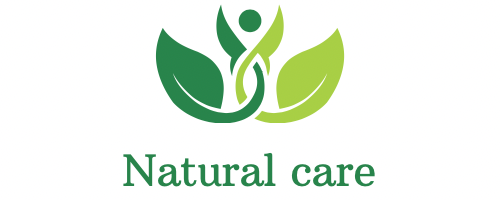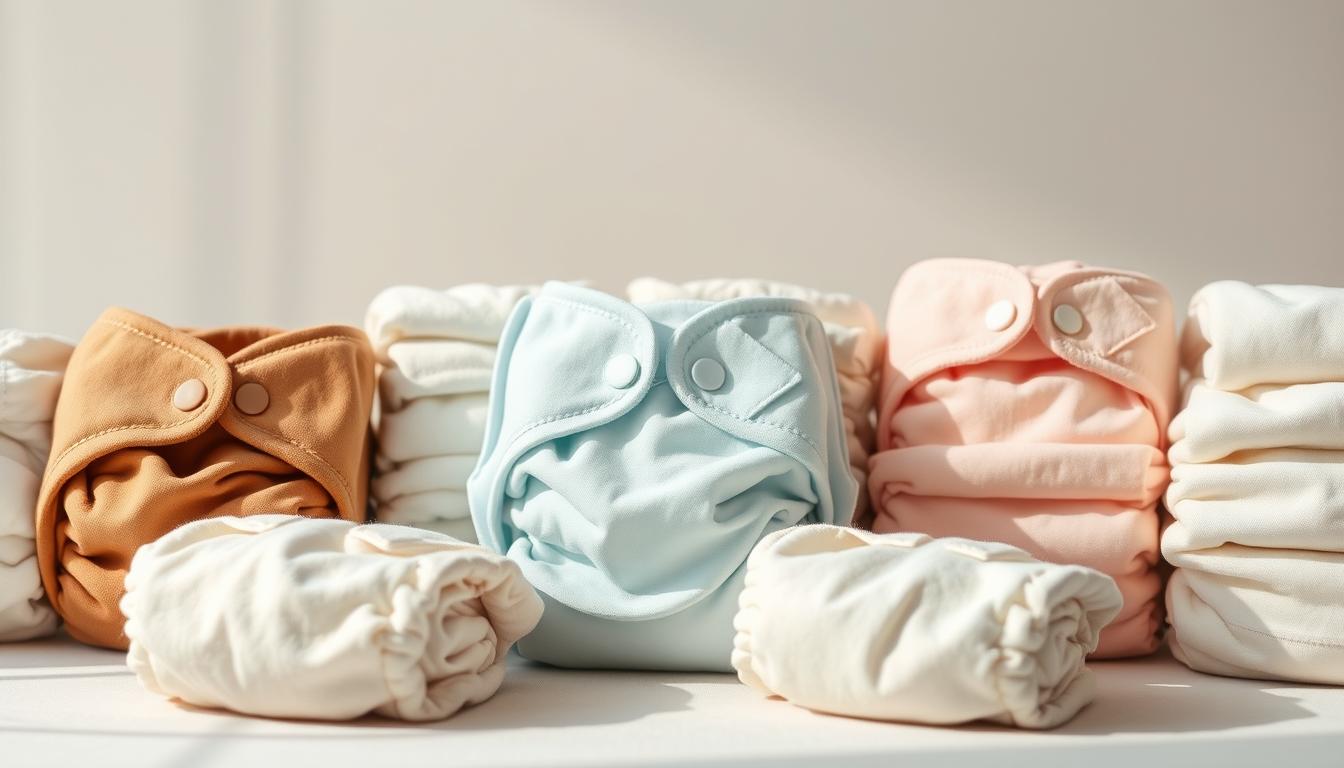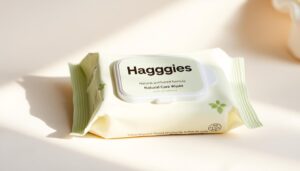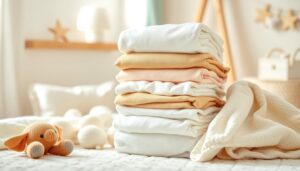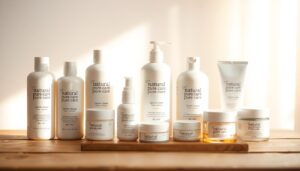Healthy Baby Diapers: Safe, Non-Toxic, and Eco-Friendly Choices
Did you know some diapers have chemicals that could cause cancer? As a parent, you want the best for your baby. But are the diapers you use safe? Healthy baby diapers are essential, not just a trend. They come with EWG Verified certifications, ensuring they meet strict safety standards.
Choosing between non-toxic, eco-friendly, and skin-safe diapers can be tough. How do you pick the right one for your baby?
Every year, over 300,000 disposable diapers end up in landfills. It takes up to 550 years for them to decompose. Conventional diapers may also contain harmful chemicals like VOCs, phthalates, and formaldehyde. Healthy baby diapers focus on both skin safety and the environment.
They use materials like bamboo or organic cotton. Brands like Pura and Kudos avoid harmful chemicals like PFAS. They prioritize your baby’s comfort and long-term health.
Table of Contents
Understanding the Importance of Healthy Baby Diapers
Your baby’s skin is in diapers for hours every day. They change diapers 10–12 times a day. The materials in these diapers are crucial for their health.
Choosing the right diapers is more than just convenience. It’s about protecting their health and future.
The Health Risks of Conventional Diapers
Traditional diapers may contain harmful chemicals like phthalates and dioxins. These can cause skin irritation and long-term health problems. A 2019 EWG study found over 60 hazardous chemicals in some brands, including formaldehyde and BPA.
These substances can harm hormones and weaken the immune system.
A 2019 study revealed over 60 potentially hazardous chemicals in disposable diapers, including phthalates and formaldehyde.
Why Your Baby’s Skin Deserves Better
Babies’ skin is 30% thinner than adults’, making it more absorbent to toxins. Chemical-free diapers avoid harmful additives that can cause rashes or allergic reactions. Organic cotton or bamboo materials in natural baby diapers reduce irritation risks.
Long-term Benefits of Choosing Healthy Alternatives
Switching to natural baby diapers reduces exposure to harmful substances. Over 35% of infants get diaper rash, but chemical-free diapers lower this risk. These choices also promote health and sustainability without sacrificing comfort.
Every diaper change is important. With 3,000+ changes in the first year, choosing natural materials supports your baby’s health and the planet’s future.
What Makes a Diaper “Healthy”?
Looking for a healthy diaper means more than just what’s on the label. It’s about safety, being open about what’s inside, and being kind to the planet. Check for certifications like EWG Verification. This shows the diaper meets high safety standards.
Healthy Baby Diapers are the first to get this seal. They avoid harmful stuff like phthalates and chlorine.
- Choose organic baby diapers with natural materials like 15% organic cotton to reduce skin irritation.
- Go for eco-friendly diaper brands that skip petroleum-based lotions and synthetic fragrances.
- Look for brands with biodegradable packaging, like Healthy Baby’s paper-based wrapping, to cut plastic waste.
- Make sure brands are clear about what’s in their diapers. Good brands list everything without using vague terms.
Healthy Baby’s diapers show you can be eco-friendly without losing quality. They’re easy to find at Target and offer a subscription service. Some brands might be cheaper but less safe. Always check for third-party approvals like EWG to be sure.
Harmful Ingredients to Avoid in Baby Diapers
Choosing non-toxic diapers means knowing what to avoid. Here’s how to spot risky materials. Pick chemical-free diapers for your baby’s skin.
Phthalates and Their Effects
Phthalates make plastics soft but harm hormones. They can affect reproductive growth. Pampers diapers don’t have phthalates, making them safer.
Chlorine and Dioxin Concerns
Chlorine bleaching creates dioxin, a toxic byproduct linked to cancer.
Pampers doesn’t use elemental chlorine, avoiding dioxin risks. Look for diapers that say “chlorine-free” to lower risks.
Fragrances and Synthetic Additives
- Artificial scents may hide dozens of undisclosed chemicals.
- Parabens (hormone disruptors) are excluded from Pampers products.
Go for unscented diapers to avoid skin irritation.
Petroleum-Based Materials
Petroleum-based plastics like PVC release toxins as they break down. Pampers diapers don’t use PVC, lowering environmental and skin risks.
Always check labels for chemical-free diapers. Look for brands like Pampers that focus on safety and transparency.
The Benefits of Switching to Non-Toxic Diapers
Choosing non-toxic diapers is good for your baby and the planet. They reduce exposure to harmful chemicals that can irritate the skin and pose health risks. By picking sustainable options, you also help cut down on landfill waste and carbon emissions.
Reduced Risk of Diaper Rash and Irritation
A 2019 ANSES study found that regular diapers contain harmful substances like VOCs, phthalates, and formaldehyde. These can cause skin reactions. Non-toxic diapers, like Bloomies, are made from 100% biodegradable bamboo, avoiding these irritants.
Organic cotton and plant-based materials in these diapers make them breathable. This can lower rash cases by up to 40% compared to regular brands.
Environmental Advantages
Traditional diapers take 550 years to break down. But, eco-friendly options like Coterie diapers use 25% plant-based materials from certified forests. Pura diapers are carbon neutral, reducing emissions by 30% with renewable energy.
Dyper’s REDYPER program turns old diapers into compost. This closes the waste loop.
Long-term Health Considerations
Babies’ skin absorbs chemicals 50% faster than adults, research shows. Brands like Hushabye use GOTS-certified organic bamboo, avoiding pesticides. Conscious Collective plants a tree for every purchase through Ecologi, meeting B-Corp standards.
OEKO-TEX certified options, like Dyper, remove over 1,000 harmful substances. This protects developing immune systems.
Types of Eco-Friendly Diaper Options
Choosing eco-friendly diaper brands means picking sustainable baby diaper options. These diapers are made from plant-based materials, biodegradable designs, and compostable systems. They are good for the planet and keep babies comfortable.
- Plant-Based Disposables: Brands like Dyper use bamboo or wood pulp, reducing reliance on plastics.
- Biodegradable Options: Parasol diapers, certified by the Nordic Swan and PEFC, break down faster than standard disposables.
- Compostable Solutions: Dyper’s program lets you return used diapers for industrial composting, cutting landfill waste.
- Certified Organic: Eco by Naty and Kudos diapers avoid harsh chemicals, backed by USDA and OEKO-TEX approvals.
Prices differ among brands. For instance, eco-friendly diaper brands like Millie Moon cost $0.49 per diaper. Coterie’s premium options focus on chemical-free materials. Biodegradable diapers like Parasol may take 250 years to decompose—half the time of traditional disposables.
| Brand | Materials | Certifications | Cost/Unit | Key Feature |
|---|---|---|---|---|
| Parasol | Wood pulp | Nordic Swan, PEFC | Premium | Cruelty-free and vegan |
| Dyper | Bamboo | Compostable | $0.59 | Compost return program |
| Kudos | Organic cotton | USDA, OEKO-TEX | $0.36 | No chlorine or dioxins |
| Freestyle | Bamboo | USDA Certified | $0.71 | Hypoallergenic |
Look for certifications like PETA’s cruelty-free seal or PEFC forest certification. Even small changes, like choosing biodegradable materials, can reduce your family’s environmental impact over time.
Top Organic Baby Diapers Brands in the US Market
Choosing the right organic baby diapers means finding a balance. You want them to be good for the planet and safe for your baby. Here are the top picks in different categories, based on tests of over 60 diapers.
Premium Organic Options
Parasol Clear and Dry is a top choice, scoring 95 overall. It has 10/10 absorption and 9.4 leak protection. Made from plant-based materials, it’s certified by FSC and OK Biobased. It costs $0.59 per diaper but offers great comfort.
Eco by Naty is another premium option. It’s made from 60% renewable materials and is compostable. Though it has a lower leak score of 5.8/10, it’s free from phthalates and synthetic additives.
Budget-Friendly Choices
If you’re on a budget, Hello Bello Premium is a good choice. It costs just $0.14 per diaper. It’s made without waste and has an 8.7 absorption score.
Millie Moon offers a soft feel at a mid-range price. Dyper Bamboo is compostable and part of their REDYPER program. These eco-friendly diaper brands are affordable without sacrificing safety.
Best All-Around Performers
Huggies Snug & Dry is great for everyday use. It has 8.0 absorption and 7.8 leak scores. Coterie and Pampers Pure Protection are top for leak prevention.
Dyper Bamboo is durable, with a 9.0 score. Honest and Pura offer plant-based materials at different prices. These brands show you can choose eco-friendly without losing comfort.
When comparing, look for certifications like Oeko-Tex or FSC. These ensure the materials are safe. Over 18 brands were tested in 29 trials. Absorption was 45% of the score. Let these brands help you find diapers that are good for your baby and the planet.
Choosing the Best Diapers for Sensitive Skin
When picking hypoallergenic baby diapers, look for ones that cause less irritation and chemical exposure. Babies with sensitive skin should avoid products with fragrances, dyes, and harsh chemicals. Here’s how to find the best diapers for sensitive skin that are safe and practical.https://www.naturalpurecare.com/haggies-natural-care-wipes/
Features to Look For
- No synthetic fragrances, dyes, or lotions
- Certifications like OEKO Tex Standard 100 for toxin-free materials
- Materials like bamboo viscose or chlorine-free wood pulp
- Stretchable leg cuffs to prevent leaks without tightness
Hypoallergenic Baby Diapers Worth Trying
| Brand | Key Features | Certifications | Price Range |
|---|---|---|---|
| Pampers Pure Protection | 12-hour leak protection, fragrance-free | TCF bleached, hypoallergenic | $1.20–$1.50 per diaper |
| Andy Pandy Bamboo | 100% bamboo viscose, PFAS-free | OEKO Tex certified | $1.00–$1.30 per diaper |
| Mama Bear Gentle Touch | Breathable outer layer, latex-free | ECF bleached | $0.80–$1.00 per diaper |
Real Parent Reviews
“I switched to hypoallergenic diapers after rashes kept coming back. Andy Pandy worked best, but I had to double-check the fit to avoid leaks.” — Parent Review
Parents often weigh performance against safety. Some mention occasional leaks with eco-friendly diapers. Yet, many find the reduced irritation worth it. Always test small batches first, as skin reactions can differ.
How to Transition to Sustainable Baby Diaper Options
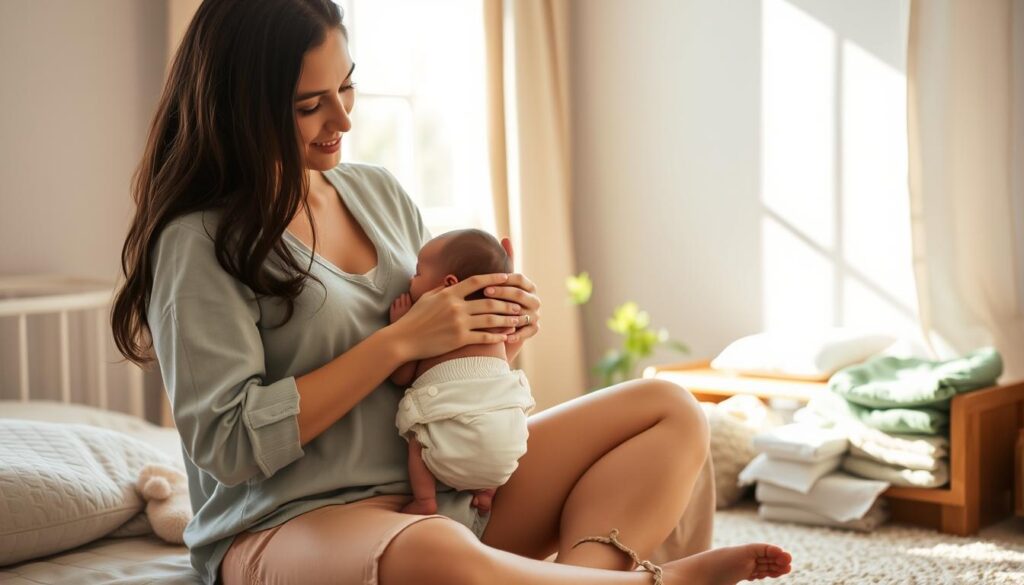
Starting to use sustainable baby diapers is easy. First, try sample packs from brands like Pura or HealthyBaby. These kits help you see how they fit and feel. You can check out different materials and absorbency without a big investment.
- Research certified options. Look for EWG Verified or FSC-certified brands like Kudos or Coterie. They avoid harmful chemicals.
- Sign up for a subscription. Brands like Dyper offer prepaid shipping and guides on composting. Their bamboo diapers are just $0.35 each with a subscription.
- Try a hybrid approach. Use cloth diapers during the day and disposables at night. This mix is both convenient and eco-friendly.
Start with 20–24 cloth diapers for 2–3 days of use before laundry. Brands like Judes make quick-drying diapers for busy lives. Many parents see their babies sleep better with breathable diapers, reducing skin issues.
Make changes slowly. Keep disposables for outings, but use sustainable baby diaper options at home. Over time, you’ll reduce waste and save up to $3,000 per child. Even a little bit of eco-friendly choice is good for your baby and the planet.
Cost Comparison: Are Healthy Baby Diapers Worth the Investment?
Healthy baby diapers might seem pricier at first, but making smart choices can help save money. Brands like Coterie and Dyper offer subscription plans that can cut costs by 10–15%. Let’s look at the numbers.
Eco-friendly diaper brands start with a higher price tag. A single Coterie diaper costs about $0.35 with a subscription. This is compared to $0.14–$0.35 for regular diapers. But, these diapers last longer—Coterie’s design holds 70% more liquid and lasts 12 hours.
With fewer leaks, there are fewer diaper changes and less waste. Over two years, parents spend $500–$1,000 on diapers. Switching to Kudos or Pura can also reduce chemical exposure and rashes. This saves money on ointments and doctor visits.
- Initial Costs: Eco-friendly diapers cost $0.35–0.59 each vs $0.14–0.35 for conventional
- Long-Term Savings: Fewer rashes, longer wear time, and less frequent purchases reduce total spending
- Environmental Impact: Conventional diapers take 500+ years to decompose; eco options break down in 250 years
Smart strategies can stretch your budget. Dyper subscriptions save 15% off bulk orders. Mixing cloth and disposable options can also cut costs. Brands like Coterie use 25% plant-based materials, making them more affordable while still being eco-friendly. Over two years, parents could save up to $200 with subscriptions alone.
Choosing healthy options isn’t just about the initial cost. It’s also about reducing landfill waste and protecting your baby’s skin. These benefits make the investment worthwhile over time.
Combining Cloth and Disposable: Creating a Hybrid Approach
Many parents mix cloth and disposable sustainable baby diaper options for success. This hybrid system offers both convenience and eco-friendliness. For instance, using cloth diapers at home and disposables when traveling or at night can reduce waste.
Begin with 24-30 cloth diapers for 2-3 days of use. Add disposables for outings or emergencies. Dyper’s Redyper program makes this easy, offering composting in 21 U.S. cities. It cuts landfill waste and keeps costs low.
- Daytime: Cloth diapers with waterproof PUL covers
- Nighttime: Overnight disposables with bamboo cores
- Travel: Compact all-in-one cloth models
“Hybrid systems prove sustainability doesn’t require perfection—it requires action.”
Choose healthy baby diapers from organic cotton or hemp. Wash cloth diapers every 2-3 days with fragrance-free detergents. Dyper’s program turns their compostable inserts into soil.
Even a little bit of cloth diapering can help. It can cut down on the 5,000+ disposables each child uses. Hybrid approaches can save 40-60% of waste. Look into community diaper services or reusable banks for affordable options.
Common Myths About Natural Baby Diapers Debunked
Sorting fact from fiction helps parents choose the best care for their baby. Here’s what the research shows:
Myth: They Don’t Perform as Well
Independent lab tests prove top natural baby diapers outperform conventional brands. For example:
| Brand | Absorption Score | Leak Resistance |
|---|---|---|
| Parasol Clear & Dry | 10/10 | Excellent |
| Eco by Naty | 9.5/10 | Superior |
| Dyper Bamboo | 5/10 | Below average |
While some brands like Dyper Bamboo fall short, leaders like Parasol deliver proven results. “These diapers soaked up liquid faster than expected,” said one lab tester.
Myth: They’re Always More Expensive
Budget-friendly options like non-toxic diapers from Hello Bello match conventional prices when bought in bulk. Subscription discounts cut costs further. Compare:
- Conventional: $0.18–$0.35 per diaper
- Organic: $0.20–$0.40 per diaper
Long-term savings come from reduced rash treatments and fewer repeat purchases due to better fit.
Myth: They’re Not Truly Eco-Friendly
Third-party certifications matter. Look for:
- Certifications like USDA Certified Biodegradable
- Plant-based materials replacing plastics
- Carbon-neutral factories
While no diaper is zero-impact, natural baby diapers cut plastic use by 60%+ compared to standard brands.
Every parent deserves facts—not myths—to make informed choices. Check labels, read reviews, and prioritize brands with transparent testing results.
Conclusion: Making the Best Diaper Choice for Your Baby and the Planet
Choosing diapers is all about what’s important to you: your baby’s skin, your wallet, or the planet. Hypoallergenic diapers like Parasol’s organic ones protect your baby’s skin. Natural options like Hello Bello help reduce waste.
Switching to biodegradable diapers can help the environment. They break down faster than regular ones. Cloth diapers save money and cut down on waste. Hybrid systems offer a balance between ease and eco-friendliness.
For those watching their budget, Huggies Snug & Dry is a good choice. But, if you care about the planet, consider cloth or biodegradable diapers. Every diaper counts, especially with over 6,000 used by each child.
Choosing the right diaper means thinking about your baby’s health and your values. Whether it’s organic, eco-friendly, or a mix, every step helps. It’s about making choices that are good for your baby and the Earth.
FAQ
What are healthy baby diapers?
Why should I be concerned about chemicals in conventional diapers?
What certifications should I look for when selecting non-toxic diapers?
Are hypoallergenic diapers different from regular diapers?
What are the environmental benefits of eco-friendly diapers?
Can eco-friendly diapers perform as well as conventional diapers?
What types of sustainable baby diaper options are available?
What should I consider when transitioning to sustainable diaper options?
Are there budget-friendly eco-friendly diaper options available?
How can I identify natural and eco-friendly diaper brands?
Source Links
- https://www.babygearlab.com/topics/diapering-potty/best-disposable-diaper
- https://naturekidsco.com/blogs/learn/top-5-best-non-toxic-sustainable-diapers-for-eco-conscious-parents?srsltid=AfmBOorRp-e0Sid764c3bhUdYoF-Qdj0jFezclJ28oRLP0suyh2RnObO
- https://breastpumps.byramhealthcare.com/blog/2024/11/12/how-to-choose-the-best-baby-diapers
- https://millionmarker.com/blogs/blog/toxic-chemicals-in-diapers
- https://www.healthychildren.org/English/ages-stages/baby/Pages/babys-first-days-bowel-movements-and-urination.aspx
- https://wellnesswithkaelyn.com/blog/healthy-baby-diaper-review
- https://www.webmd.com/parenting/baby/how-to-choose-baby-diapers
- https://www.pampers.com/en-us/about-us/quality-and-safety/article/ingredients-not-in-pampers
- https://www.consumerreports.org/babies-kids/diaper-creams/how-to-choose-a-diaper-cream-without-harmful-chemicals-a3949764047/
- https://www.consumerreports.org/babies-kids/baby-wipes/how-to-choose-baby-wipes-without-harmful-chemicals-a1051850790/
- https://naturekidsco.com/blogs/learn/top-5-best-non-toxic-sustainable-diapers-for-eco-conscious-parents?srsltid=AfmBOooRL9o4tSPjIJ5N4oKPfJF8rPSWg_-oqzPBtAlGtJ2mshALpH7x
- https://hushabye-baby.com/blogs/blog/non-toxic-what-it-means-and-why-its-important-for-baby-products?srsltid=AfmBOopUcfoOwkNi0NYqWA76XnbxNJ_ArV3ZaF-weBfnRGWsBpUOhlRz
- https://www.babyquip.com/blog/eco-friendly-diapers
- https://www.kinderclothdiapers.com/blogs/cloth-diapering/choosing-the-best-eco-friendly-diapers-for-babies-and-toddlers?srsltid=AfmBOorZgh8-FWGp20uu4Mmtbtm8kPAZyxf2Yz70PMTrBJukXRJSolBw
- https://www.greenmatters.com/green-matters-approved/natural-diapers
- https://nontoxicvibes.com/2024/08/13/top-non-toxic-diapers-an-ultimate-guide/
- https://www.babycenter.com/baby-products/diapering-essentials/best-diapers-for-sensitive-skin_40009452
- https://www.forbes.com/sites/forbes-personal-shopper/article/best-diapers-for-sensitive-skin/
- https://bayrli.com/blogs/resources/transitioning-to-cloth-diapers-a-step-by-step-guide-for-beginners?srsltid=AfmBOoo9YOweys6VceZLZj5xU5uOU_qW6r4ov8WymuOM2H-iEw2Wynn-
- https://www.judesfamily.com/en/blogs/academy/abhalten-von-babys-eine-naturliche-alternative-zur-windel?srsltid=AfmBOoq4tYDtsKDsxjKH7LRn6gi0Yje1vOZ3B9KcoKb-0Mu2O6UgStGo
- https://naturekidsco.com/blogs/learn/top-5-best-non-toxic-sustainable-diapers-for-eco-conscious-parents?srsltid=AfmBOortk_QrjSborLJPpQxRtaZFCQ_lzDp4MHOBRiS3znb0GLGorlfN
- https://naturekidsco.com/blogs/learn/top-5-best-non-toxic-sustainable-diapers-for-eco-conscious-parents?srsltid=AfmBOopir6bUL5I9mA6Za8FiIoh27M95BqFxTvSXQJHH3-PINvvHN8XD
- https://www.coterie.com/blog/what-makes-a-great-diaper?srsltid=AfmBOoqEwml6g24KpBaInv2N8lBjfdP6W6-JvQTsCRArajY0WWmyGFqW
- https://bayrli.com/blogs/resources/transitioning-to-cloth-diapers-a-step-by-step-guide-for-beginners?srsltid=AfmBOop0k4xtIZ4V7zPRI5mxbQFdJ5WLf-qRXSMyY5lFms92ojcYxza0
- https://www.grovia.com/pages/learn-cloth-diapers?srsltid=AfmBOopNiv9wbVtt4oR1DXefxu8KWIRCIrukRbHuCmEomBrtOBqTNuvb
- https://superbottoms.com/blogs/diapering/cloth-diaper-traditions-across-cultures?srsltid=AfmBOoqfch7hKFgv8ng70BvkbH_-urVzl56wkeiwb9kK3My4wbV1ue30
- https://www.thrivelactationcenter.com/blog/jdl7m975lz8fzbhhyibh7wjksja327
- https://www.parents.com/baby/care/14-most-outdated-pieces-of-baby-advice/
- https://triplepaste.com/blogs/blog/diaper-rash-myths-debunked
- https://www.choicequad.com/categories/baby-products/how-to-choose-baby-diapers-a-comprehensive-guide/environmental-impact-of-baby-diapers-a-guide-to-eco-friendly-choices
- https://kindero.co/blogs/humid-diapering/why-more-parents-are-choosing-reusable-diapers-a-guide-to-eco-friendly-diapering
